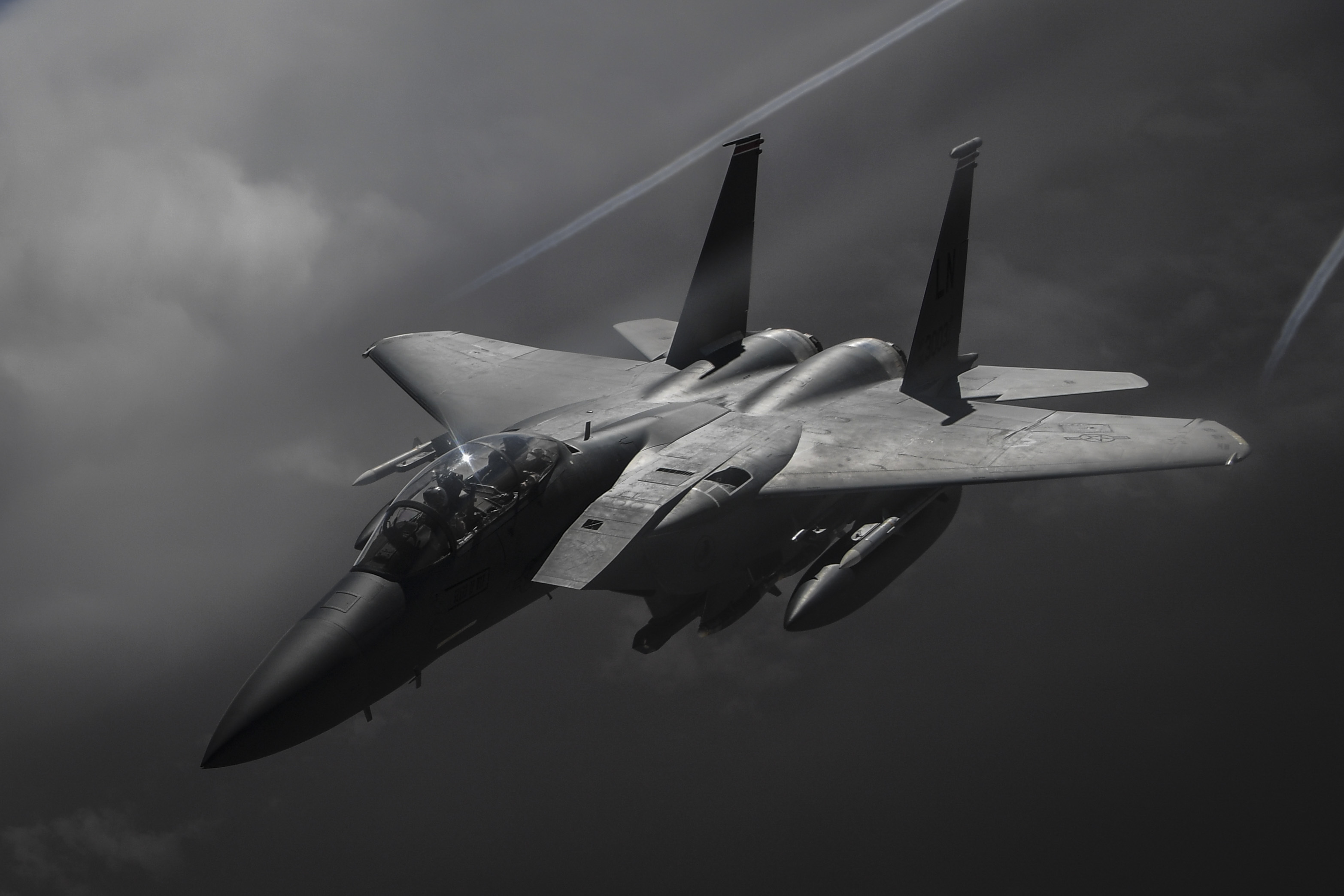Checkpoints: The F-15 Eagle
50 years of air dominance
The F-15 Eagle has an unblemished air-to-air combat record, with its pilots shooting down more than 100 enemy aircraft without a single loss.
Now celebrating 50 years of service — the first F-15, manufactured by McDonnell Douglas, was delivered in November 1974 — the Eagle remains a versatile and important part of the U.S. Air Force’s inventory, along with the fourth-generation F-16 Fighting Falcon and the fifth-generation F-22 Raptor and F-35A Lightning II.
Thousands of U.S. Air Force Academy graduates have piloted or supported the F-15, and thousands more likely will in the future as the latest variant — the F-15EX Eagle II — is projected to fly into the 2050s.
The need for a modern fighter aircraft that could command and control the skies became glaringly clear during the Vietnam War. In 1965, the U.S. Air Force launched an air war against North Vietnam with the F-105 Thunderchief, the F-100 Super Sabre and, its top fighter at the time, the F-4 Phantom, which was designed for long-range missile attacks and not dogfighting. The North Vietnamese flew Soviet-made MiG-17s early on before their top fighter, the MiG-21, became operational.
“The Air Force expected our air-to-air fighters to achieve the historic kill ratios of the Korean War, which, depending on which source you used, ranged from 10-to-1 down to 6-to-1,” says Col. (Ret.) Douglas Dildy ’74, a former F-15 pilot and co-author of the book, F-15 Eagle Engaged: The World’s Most Successful Jet Fighter. “We were barely getting 2-to-1, and in some periods, we were not even getting that.”
He adds: “We were losing very expensive airplanes to a very inexpensive enemy, as far as their equipment, and we were unable to protect the bombers that were going in.”
The U.S. Air Force lost 382 F-4s in combat.
“Air Force staff realized that the compromise of using the former Navy fighter [F-4], and not developing their own air-to-air, air superiority fighter, severely handicapped us and resulted in large losses over North Vietnam, hence the requirement for a dedicated air superiority fighter [that] became known as the F-15 Eagle,” Col. Dildy explains.
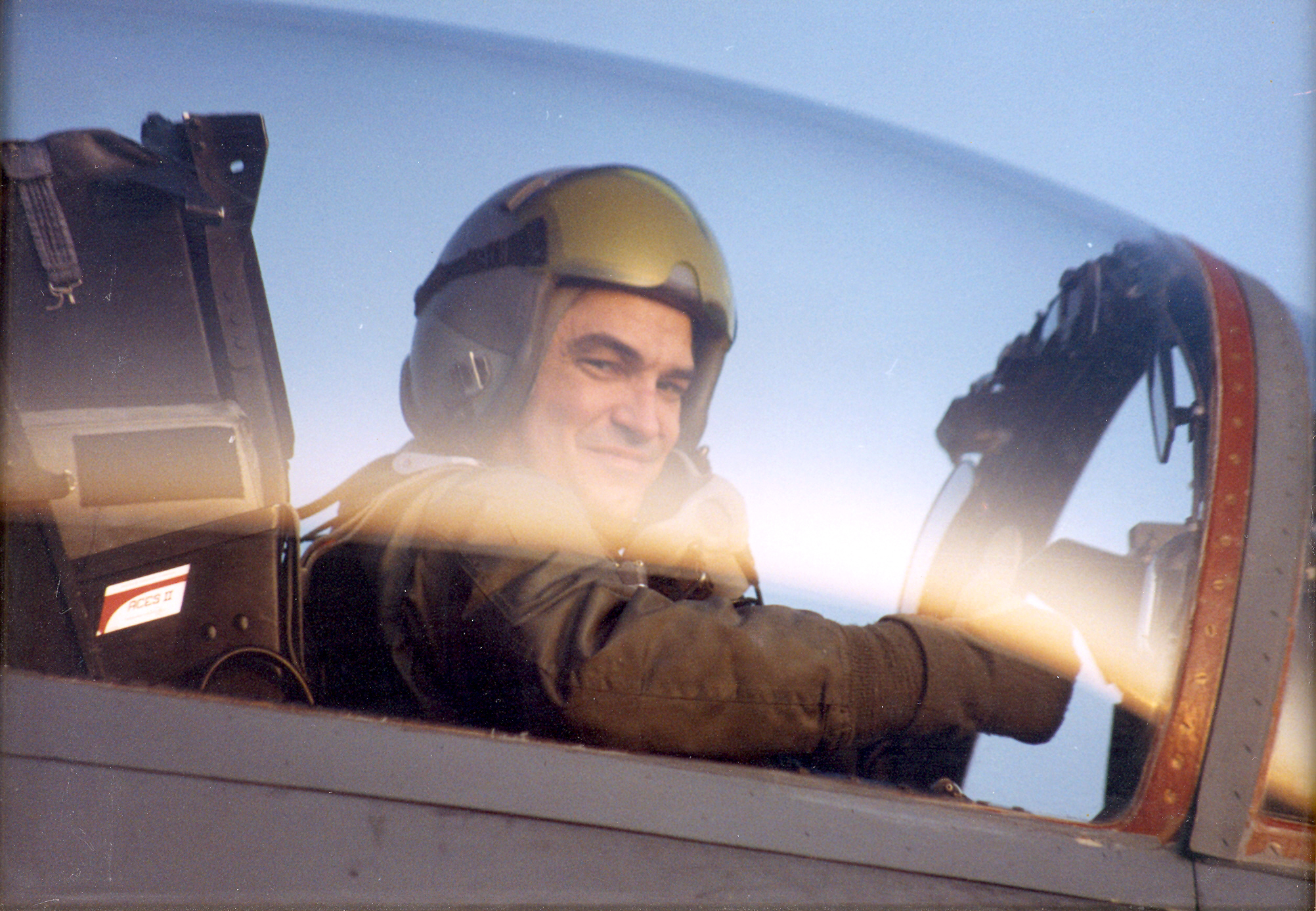
The single-seat F-15C and two-seat F-15D models entered the Air Force inventory in 1979 and were first delivered to Kadena Air Base, Japan. Forty-five years later, those models are expected to be replaced with the F-15EX Eagle II, a 4.5-generation tactical fighter with arguably 6th-generation avionics.
The F-15E Strike Eagle entered service in September 1989 and has been a mainstay ever since. In addition to the air superiority offered by the F-15’s previous versions, the F-15E offered ground-attack capability, among other improvements.
The Strike Eagle is as useful now as it was 30-plus years ago. For example, dozens of airmen, including two in an F-15E Strike Eagle recognized with the Silver Star Medal, were recently recognized for their efforts during the largest air-to-air enemy engagement in more than 50 years.
Hundreds of drones and missiles launched from Iran and Houthi-controlled areas of Yemen against Israel on April 13-14 were shot down.
“Our airmen stood firm alongside our coalition partners to protect Israel from a barrage of one-way attack UAVs and missiles,” says Gen. James Hecker ’89, U.S. Air Forces in Europe-Air Forces Africa commander, who presided over the ceremony. “The success of our airmen demonstrates how the U.S. Air Force is ready to respond to and defeat evolving threats.”
Boeing delivered the newest Eagle, the F-15EX Eagle II, in 2021. This past July, the Portland (Oregon) Air National Guard Base was the first to receive the new airframe. It was the first time a new weapons system went to the Air National Guard before the active-duty Air Force.
Checkpoints spoke with USAFA graduates with personal experience in the F-15. Here are seven short stories from grads ranging from 1963 to 2021.
Fogleman ’63
Long before he became the first USAFA graduate to serve as chief of staff of the Air Force, Gen. (Ret.) Ronald Fogleman ’63 showcased the capabilities of the F-15 in the skies over Europe, thrilling aviation enthusiasts with his aerial displays.
From May through September in both 1977 and 1978, then-Lt. Col. Fogleman performed international airshows nearly every weekend as a U.S. Air Forces in Europe F-15 demonstration pilot.
“Being able to represent the United States of America with the greatest fighter in the world [at that time] was a real hoot,” recalls Gen. Fogleman, a 2001 USAFA Distinguished Graduate.
“In my air shows, I would demonstrate the short field capability of the airplane by flying a 23-unit approach, touching down right on the end of the runway, lowering the nose and putting all my confidence in the anti-skid system. I could stop that airplane in 1,200 feet,” Gen. Fogleman says. “That used to blow people’s minds.”
The airshows began with Gen. Fogleman taking off with only 10,000 pounds of fuel rather than the full 36,000 pounds. The lighter load allowed him to reach a speed of around 350 knots about 7,500 feet down the runway. Then he would pull the F-15 straight up and climb vertically to about 13,000 feet before dumping a bit of fuel, creating a vapor so onlookers on the ground could spot the aircraft.
“This demonstrated the tremendous thrust that the airplane had,” Gen. Fogleman says.
He performed a slow-speed pass, making it look like the F-15 was not moving through the sky; executed a tight 360-degree turn, which he says no other aircraft could do; and would land and exit the runway with the nose of the aircraft off the ground.
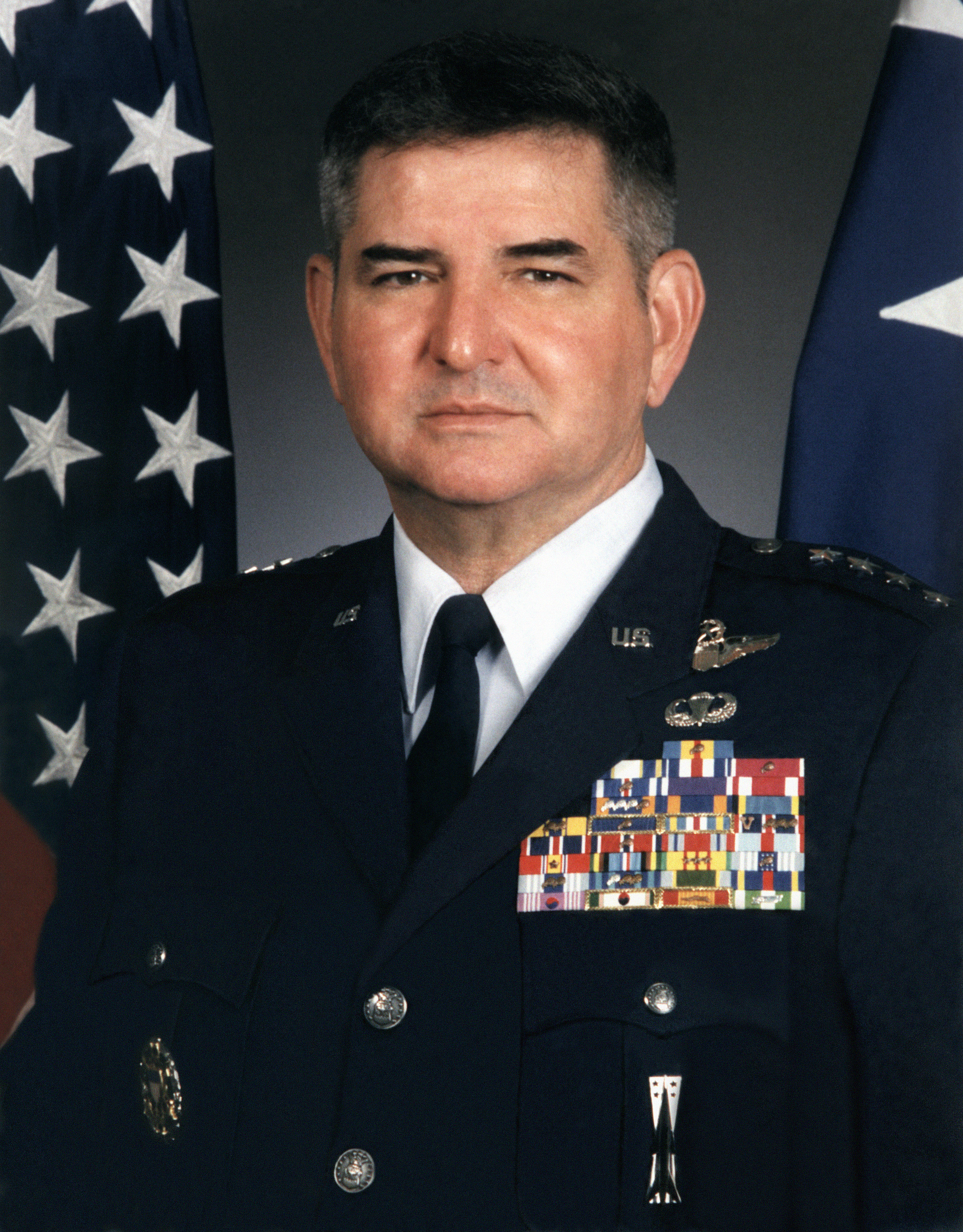
Gen. Fogleman, who flew 315 combat missions and logged 806 hours of combat flying, was operationally ready in multiple aircraft, including the F-100, F-4, F-15, F-16 and A-10. The F-15, though, stood out from the rest.
“When the F-15 came out — I flew my first ride in January of ’77 — it was such a quantum leap forward in capability, avionics and engines and performance that you didn’t have to be a great pilot to impress people,” Gen. Fogleman says. “All you had to do was land anywhere in the world and they knew that was the top fighter. [In] the way it could perform, what it could do, what it eventually evolved into, [it] was an amazing airplane [and] we’re still producing a version of it today. They don’t last that long unless they’re very useful and a great tool for the inventory.”
Still, Gen. Fogleman wants to see a stronger push toward the next generation of fighters. “It’s a shame that we have not progressed with airframes to the point that we do not need to take a fourth-generation fighter and dress it up and give it a new internal system,” he says. “I’d like to see an entire sixth-generation airplane out there.”
Carpenter ’73
Col. (Ret.) William “Trapper” Carpenter ’73 flew more than 5,200 hours, including 3,600 hours in F-15A/B/C/D/E variants over a 34-year active-duty career.
As a captain at the time, Carpenter felt fortunate to be with the individuals brought in when the F-15 was still in its infancy. USAFA grads like Gen. (Ret.) Kevin Chilton ’76 and Col. (Ret.) Michael Bloomfield ’81, both eventual NASA astronauts; Lt. Col. (Ret.) Tim Wolters ’78, former 94th Fighter Squadron commander; and Gen. (Ret.) Herb Carlisle ’78, whose last Air Force assignment was as commander of Air Combat Command — to name a few.
Even as a young pup, the talent and experience that the Air Force brought to make this new weapons system combat-ready amazed Col. Carpenter. It was a complete team effort across the board — logistics, support, maintenance, weapons experts and pilots to include test, instructors and operational.
Most of the initial F-15 instructor pilots and commanders were Vietnam veterans, often having flown F-4s and F-105s in combat.
“We owe so much to all of those that served our nation with such distinction and sacrifice, in some cases the ultimate sacrifice,” says Col. Carpenter, who serves on the Association of Graduates board of directors. “They all continue to be an inspiration.”
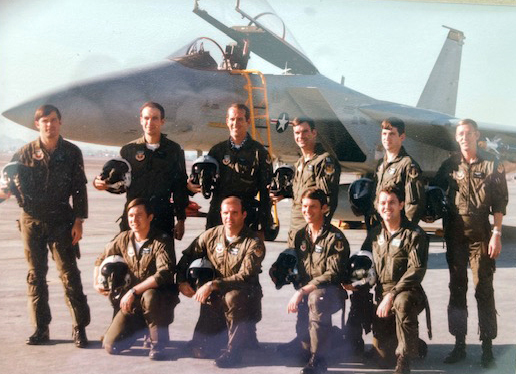
At the time, the F-15 established a reputation as the world’s most capable air superiority fighter. Advances included maneuverability and avionics to include radar, weapons loads and range. The single-seat A and C models (B and D models being the two-seat versions) were primarily designed for air-to-air engagements while the later-developed E model added air-to-ground capability to include nuclear weapons.
Col. Carpenter says he once landed, without any gear, an F-15 loaded with eight live missiles, three 660-gallon external fuel tanks and 940 rounds of 20mm bullets.
Despite explosions upon touchdown and burns primarily to the underside of the aircraft, the aircraft returned to the fleet after maintenance repairs and testing to ensure it was fully operational. All eight missiles — after replacing wings/fins along with several bench tests — were also returned to maintenance/weapons.
It was attributable to the aircraft’s survivability and to the training its pilots received, Col. Carpenter states.
“I was extremely fortunate to be a small part of the F-15 community for so many years — spanning six operational tours along with Fighter Weapons School,” Col. Carpenter says. “It was an honor to have served with so many highly dedicated, talented professionals all along the way.”
Prather ’86
Lt. Col. (Ret.) David Prather ’86 always knew he wanted to fly fighters.
His father, a C-130 pilot, introduced him to the Thunderbirds during an airshow in the 1970s.
In high school, Col. Prather set his sights on being accepted into the Air Force Academy and receiving a guaranteed pilot slot. A miniature F-15 hung from the rearview mirror of his car as a daily reminder of his dream.
“The idea of an air superiority fighter designed for one mission — to shoot down bad guys — was kind of a romantic thing that I bought into,” Col. Prather says.
As a young captain, Prather put his preparation into practice. On Jan. 19, 1991, during the Persian Gulf War, he piloted his F-15 from Incirlik Air Base, Turkey, south into Iraq for the first time.
He flew in the No. 3 spot as four U.S. aircraft made their way to Qayyarah Airfield West, an Iraqi Air Force base south of Mosul. The team quickly spotted on their radar two unknown aircraft, about 50 miles out, heading right toward them.
“At first, we didn’t know if they were friendlies or bad guys,” Col. Prather says. “I knew it was real when the flight leader called to jettison our fuel tanks.”
Just over 10 miles away, the two aircraft were confirmed hostile, and the No. 3 and No. 4 F-15s engaged.
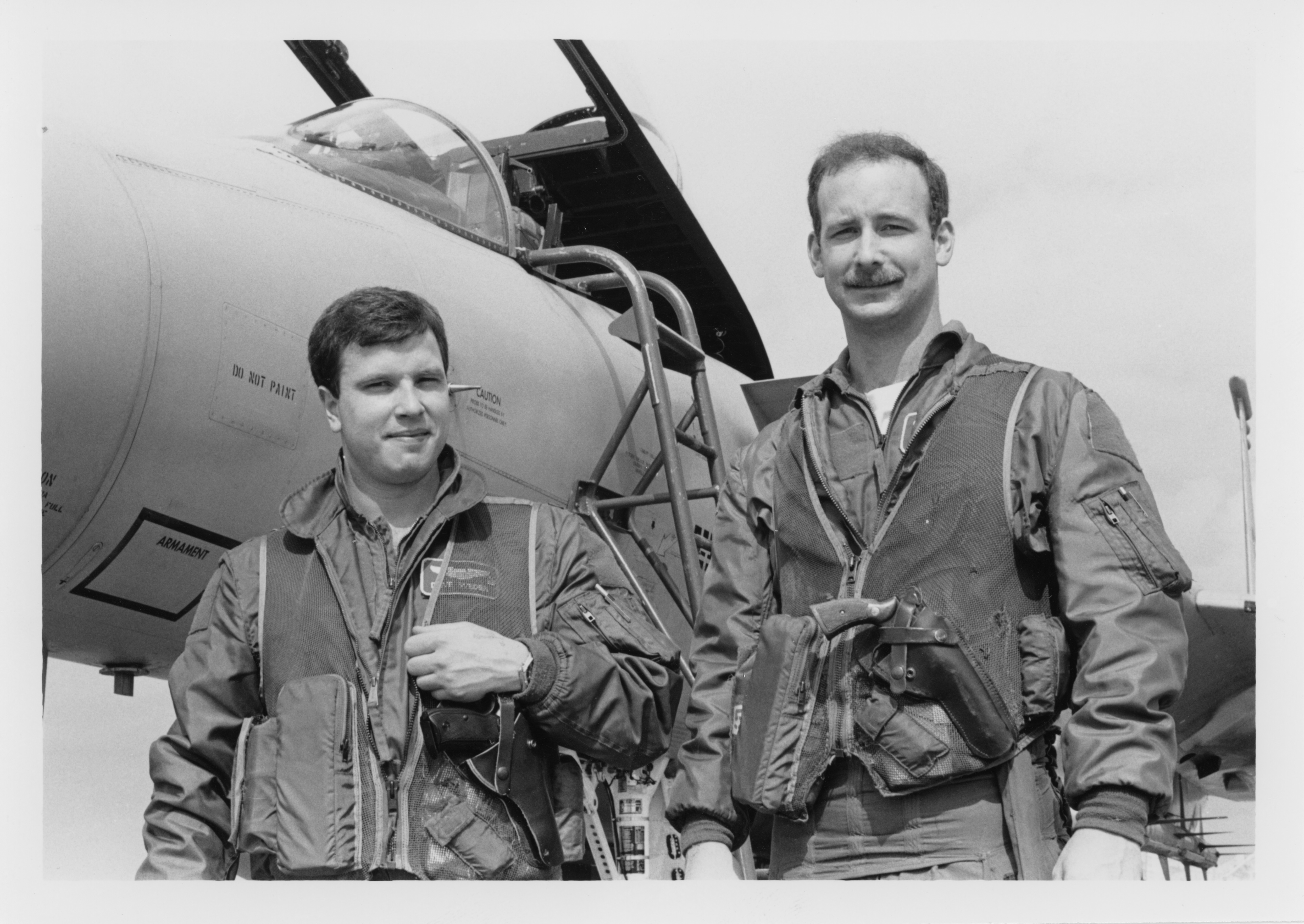
Col. Prather’s first AIM-7 Sparrow radar-guided missile went off target, but the second blew apart an Iraqi Mirage F1, sending a bright flash and fireball into the sky, just as his wingman also shot down another Mirage F1.
Two other Academy classmates on the mission saw the fireballs from 30 or 40 miles away.
“There was an immediate feeling of exhilaration as we flew over the fireballs and the wreckage going down into the Tigris River, but you’re also worried about who was going to come next,” Col. Prather says.
All the F-15s returned safely to Turkey, where a celebration of the ninth and 10th air-to-air kills of the war began.
“The ground crews were so excited to see airplanes with no tanks and missing half the missiles,” Col. Prather says. “That sense of teamwork and camaraderie was something I never experienced before or since. To go out and do what we had dreamed of doing and what the airplane was made to do was very special.”
Giese ’96
It wasn’t until his senior year at the Academy that Matt “Phat” Giese ’96 tried flying. This was a tall order for the pre-med biology major who was prone to motion sickness and afraid of heights.
But the Air Force needed pilots.
Giese chose to go through the Enhanced Flight Screening Program to avoid explaining himself to the commandant. He surprised himself by finishing No. 1 while piloting the T-3 Firefly, an aircraft quickly scrapped by the Air Force after three deadly training accidents involving cadets and their trainers between February 1995 and June 1997.
Despite his fear of heights, Giese committed to pilot training.
“I know I can always go back to school, but they’ll probably never let me go back and fly a fighter jet,” he remembers thinking. “I never really looked back, and I’ve been in fighters ever since.”
He was one of the last lieutenants to arrive at Moody Air Force Base, Georgia, to fly the F-16 and potentially the first to transition back to an F-15C. He flew numerous operational missions out of Alaska following the 9/11 terrorist attacks.
Giese graduated from Test Pilot School at Edwards Air Force Base, California, in 2005 and stuck around, testing out the F-16 and F-22.
He joined the Air Force Reserve in Alaska and flew the F-22 for seven years while also working for Boeing in Seattle, performing avionics testing in a 757 Flying Testbed with an F-22 radar nose and a sensor wing.
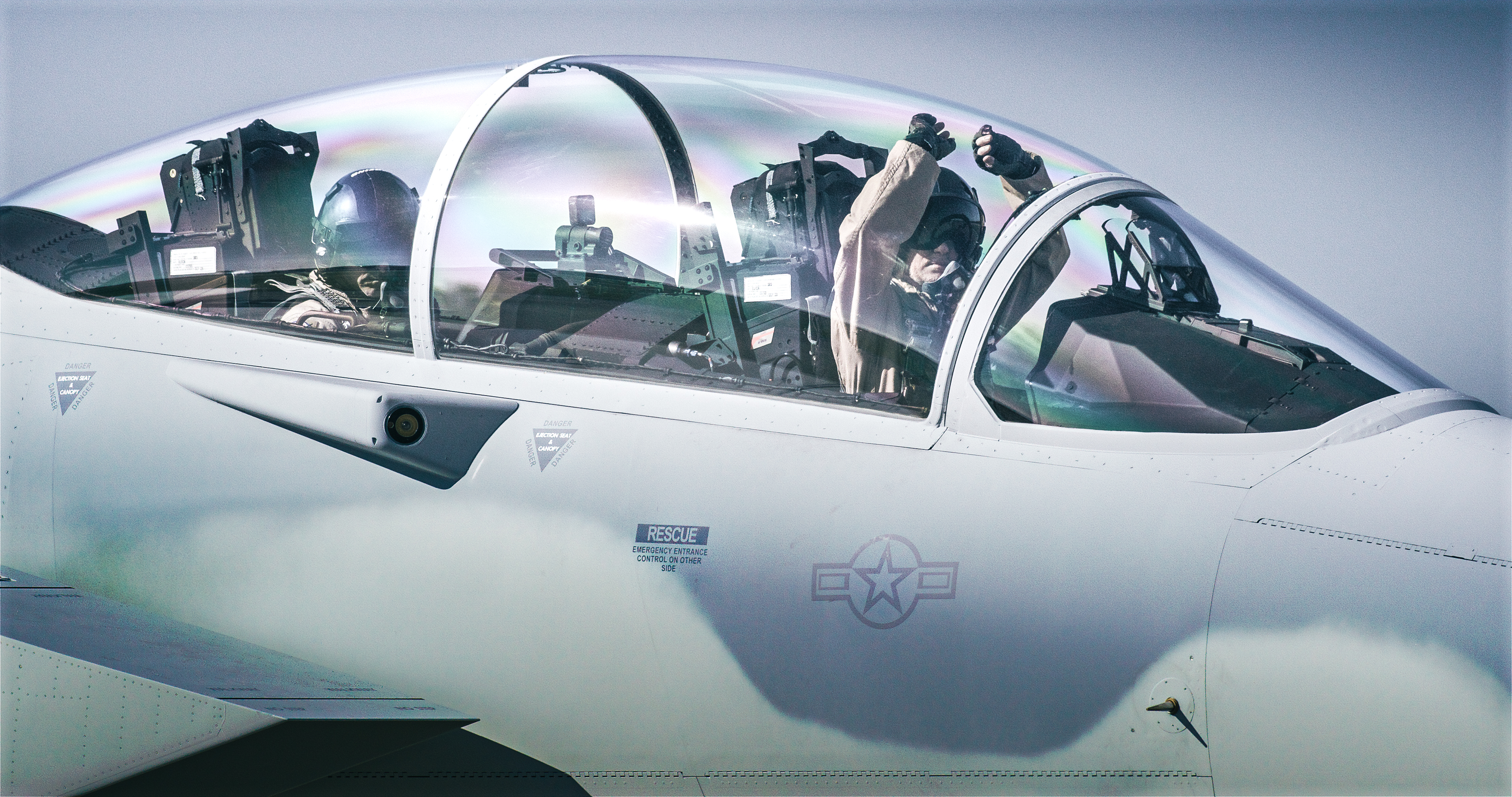
Giese has spent over a decade in St. Louis, Missouri, where he tests multiple platforms and serves as Boeing’s F-15 chief test pilot.
The F-15EX Eagle II is built and tested at Boeing’s Missouri facility.
While the outer structure of the aircraft has not changed much in 50 years, Giese explains that the performance and capability differences are night and day.
“The entire airframe has been remodeled from the inside out with a digital fly-by-wire flight control system, all-new mission systems, an advanced radar and advanced EW [electronic warfare] system, and a mission computer that is the most advanced in any fighter jet on the planet today,” he says. “You combine all that with what essentially amounts to a large iPad to tie all the systems together, to give the pilot the ability to mission-manage better, as opposed to wasting valuable excess capacity on an old school legacy mechanical flight control system.”
Taken together, he affirms, “all these improvements have allowed the F-15 to become very survivable and incredibly lethal.”
Rivers ’01
Erica “Harley” (Hamblin) Rivers ’01 came to the Air Force Academy knowing she’d get a top education and an opportunity to serve her country.
A few years into her academic, athletic and military training, Rivers decided she wanted to fly for the Air Force, but her eyesight made that impossible.
“Instead of sitting up front in a fighter, I became a weapon systems officer, sitting in the back seat while identifying targets to hit,” Rivers says.
Throughout her military career, Rivers flew in the F-15E Strike Eagle. She deployed to Bagram Airfield, the largest U.S. military base in Afghanistan at that time, during the late spring and summer of 2007 and again in the winter and early spring of 2009 amid the Global War on Terrorism.
As a weapon systems officer, Rivers managed the weapon systems targeting and employment, the air-to-ground radar, hazard avoidance and some aircraft communications.
Rivers stressed that crew coordination was vital to success.
“Being able to look in the targeting pod and really focus on what I can see on the ground versus what the pilot is seeing outside the window, and vice versa, having that coordination between the two is one of the coolest things about the Strike Eagle,” she says.
The Taliban’s preference for fighting when it was warm kept Rivers and her squadron busy during her first deployment.
Missions were often around four hours, with the F-15E responding to calls for close air support due to troops in contact with the enemy.
“We could strafe or drop bombs to make sure our guys on the ground got home safe,” Rivers says. “Sometimes it was just providing a loud noise so the enemy knew we were there. Other times, it was just looking ahead of the people on the ground, trying to make sure the route was clear and that nobody’s waiting for them.”
Rivers says she also worked with British Joint Terminal Attack Controllers — who called in air support from the ground — a lot on that deployment.
“One of the most memorable experiences was when we worked with British JTACs,” Rivers recalls. “We talked with them day and night when we were protecting them on the ground. Meeting them face-to-face after the deployment was something I’ll never forget. Those people were obviously true heroes and remarkable human beings.”
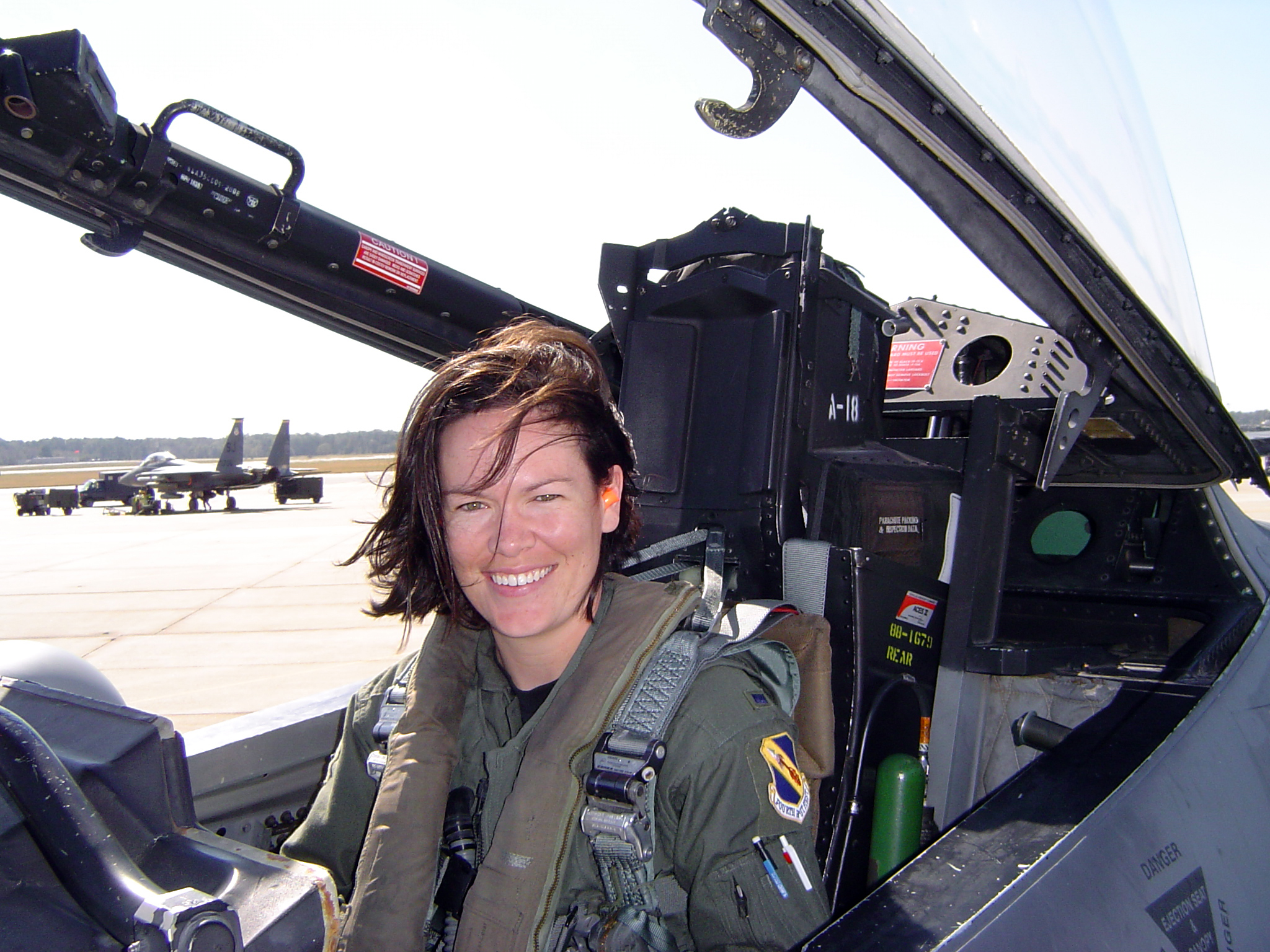
When new weapon systems officers arrived at the squadron, Rivers was one of the instructors making sure they were mission-qualified and ready to head out the door to war.
“That’s where I kind of got my bug for teaching,” Rivers says.
After separating from the Air Force, Rivers earned a Master of Education and now teaches high school math in Alaska, where her husband, Col. Jeffrey Rivers ’01, is the 3rd Operations Group commander at Joint Base Elmendorf-Richardson.
Rivers has a Strike Eagle picture behind her desk at school.
“I don’t talk about it much, but it helps when as a math teacher I can say, ‘Do you think I did math in the F-15? Yeah, I did math in this fighter,’” she recalls. “That’s been a neat way to connect with my students and share some real-world experiences outside of the classroom.”
Bledsoe ’11
Flying over Iraq and Syria in the F-15E Strike Eagle, Maj. Joseph “Paveway” Bledsoe ’11 worked to eliminate ISIS fighters in 2017-2018 during Operation Inherent Resolve.
Bledsoe flew more than 70 sorties and logged more than 340 combat hours with his squadron, the 336th Fighter Squadron out of Seymour Johnson Air Force Base, North Carolina.
“The mission capabilities the Strike Eagle provides are immense and that’s one thing that attracted me to it,” Bledsoe says. “Dropping bombs and supporting the guys on the ground with close air support is critical, but the air-to-air capabilities, a bunch of missiles and the huge radar in the front provide great capability.”
Occasionally, the military personnel on the ground who Bledsoe and others were protecting from above would pass through his base and he would get the chance to talk with them.
“One of the most rewarding parts of the deployment was getting to talk to some of the guys on the ground outside of a combat zone,” Bledsoe says. “They would say, ‘Thank you, sir. Thank you for being overwatch for us.’ I could shake their hand or give them a hug, depending on the circumstances. That was very rewarding.”
Bledsoe also appreciates working as a team and dividing duties with the weapon systems officer in the back seat of the Strike Eagle.
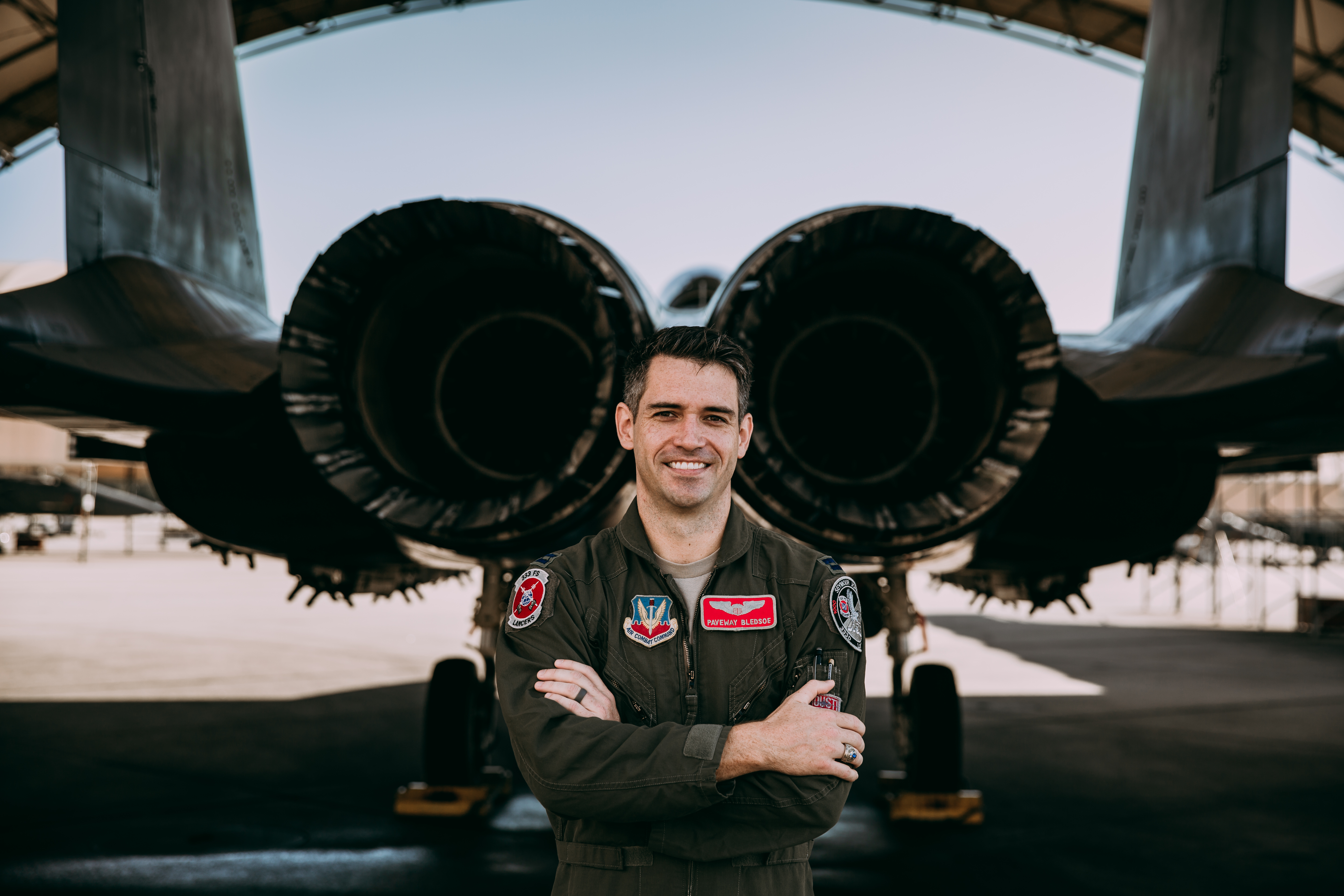
“I’ve been in many situations where my backseater is chasing targets on the ground while I’m chasing targets in the air,” he says. “And when you have a crew working together on the same page, it’s a deadly aircraft.”
Bledsoe is currently assigned to the Air Force Academy, where he is an Institute for Future Conflict fellow looking at how future air power in the Pacific may be applied. He sees roles for aircraft ranging from fourth-generation fighters like the F-15E and the F-15EX Eagle II (a fourth-generation-plus aircraft) to the latest sixth-generation bomber, the B-21 Raider.
“[The F-15E] is not meant to be like the 5th-gen, going in and kicking doors down. There are exquisite platforms like the F-22 and F-35 for that,” says Bledsoe, who serves on the AOG board of directors. “However, when you can strap 12 air-to-air missiles, or more bombs than anybody else knows what to do with, to a fighter aircraft and put four of them out there together, we’re the middle linebackers. If something gets through, we’re happy to take care of it. So that’s a look at the future of air power in terms of what platforms and capabilities are needed in a potential peer-to-peer adversary fight.”
Richichi ’21
Like many USAFA graduates who came before him, 1st. Lt. Brendan Richichi ’21 was instantly fascinated by fighter jets after attending an air show.
“I was 4 or 5 years old, and I just would not stop talking about airplanes,” Richichi recalls. “I was enamored with them.”
To fuel that passion, Richichi’s mother, Lori, painted a mural of three F-15s and an F-16 flying in formation through the clouds on his bedroom ceiling.
Fast-forward 20-plus years and Richichi is an F-15E Strike Eagle pilot with the 391st Fighter Squadron at Mountain Home Air Force Base, Idaho.
Richichi has had several “pinch me” moments in his young career. Among them: seeing another Strike Eagle outside his cockpit window while flying through the clouds; flying at 500 knots roughly 500 feet above the Appalachian Mountains (which he says made him feel like he was in the latest Top Gun movie); and simply the sound of starting up the F-15E.
“Every time I got into the airplane during B-Course and fired it up, I had this pinch-me moment of, ‘How did I get to this beast of an airplane?’” he says. “Flying this jet is a dream, and I cannot believe I get to do this.”
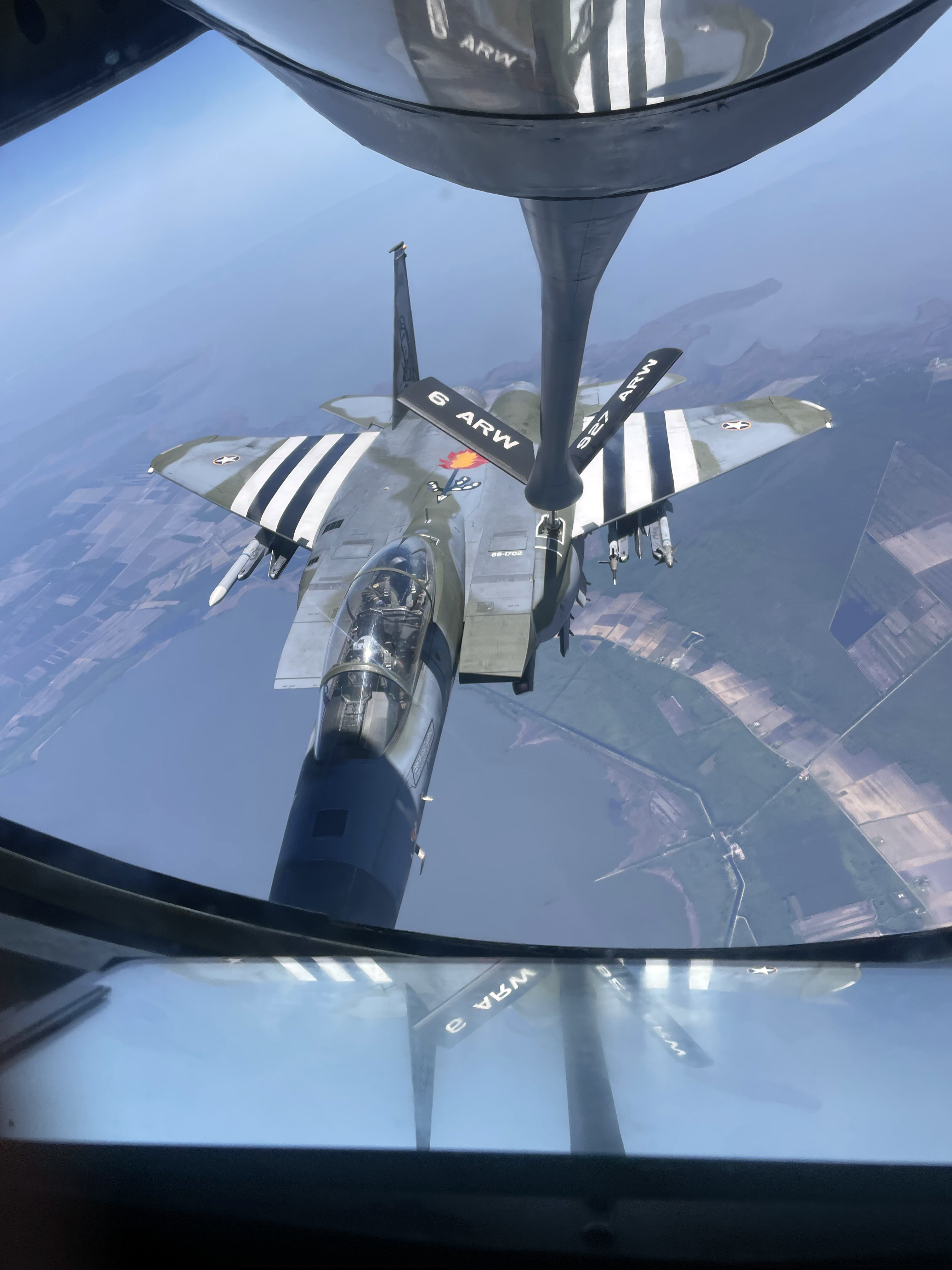
A deeper realization occurred when Richichi and the weapon systems officer were both qualifying on the aircraft. They each dropped bombs and fired the 20mm six-barrel cannon.
“I realized how serious this is and that there is not much room for error,” Richichi says. “We’re training for something real and for a threat that we’re probably actually going to go fight.”
Back at B-Course pilot training, Richichi remembers a commander bragging about the F-15, saying something like, “I love this jet because it can carry every weapon, it can do every mission set, and it’s one of the most survivable jets we have in the inventory. It’s made to go to battle, it’s very good at it, and it keeps its aircrews safe. That’s proven.”
Richichi agrees.
“When I compare the F-15E to the F-35 and F-22 that some of my buddies fly, F-35s and F-22s are like Corvettes,” Richichi says. “They are beautiful and have all the high-speed, high-tech stuff, but the Strike Eagle, and Eagles as a whole, are like muscle cars. The jet talks to you — you can feel it while flying it, and it still breathes fire. It’s spectacular.”

